- Description of the Selected Community
- Major Health Problems in the Community
- Factors Contributing to Illness during Childbearing
- Health and Human Services Agencies Available in the Rural Community
- Steps for Referring a Patient/Family to Identified Agencies
- Importance of A Healthy Community in Successful Childbearing/Childrearing
- References
Description of the Selected Community
This project involves a comprehensive assessment of the East Flatbush community. East Flatbush is a residential neighborhood in the Brooklyn borough, New York City. The community had an estimated population of 136,009 people in 2019, with 48.1% and 43.9% of the residents being foreign-born and native New Yorkers, respectively (NYU Furman Center, 2019).
There has been a drastic decline in the community’s population since 2000 where the number of people living in this area dropped from 145,263 in 2000 to 147,390 in 2006, to 140,285 in 2010, and then to 136,009 in 2019 (NYU Furman Center, 2019). East Flatbush is a predominantly black community. According to recent estimates, African Americans account for the largest proportion of the neighborhood’s population at 86.3%, followed by Hispanics, Whites, and Asians at 7.1%, 3.1%, and 1.2%, respectively (NYU Furman Center, 2019). These statistics clearly indicate that blacks are the dominant racial group in this neighborhood.
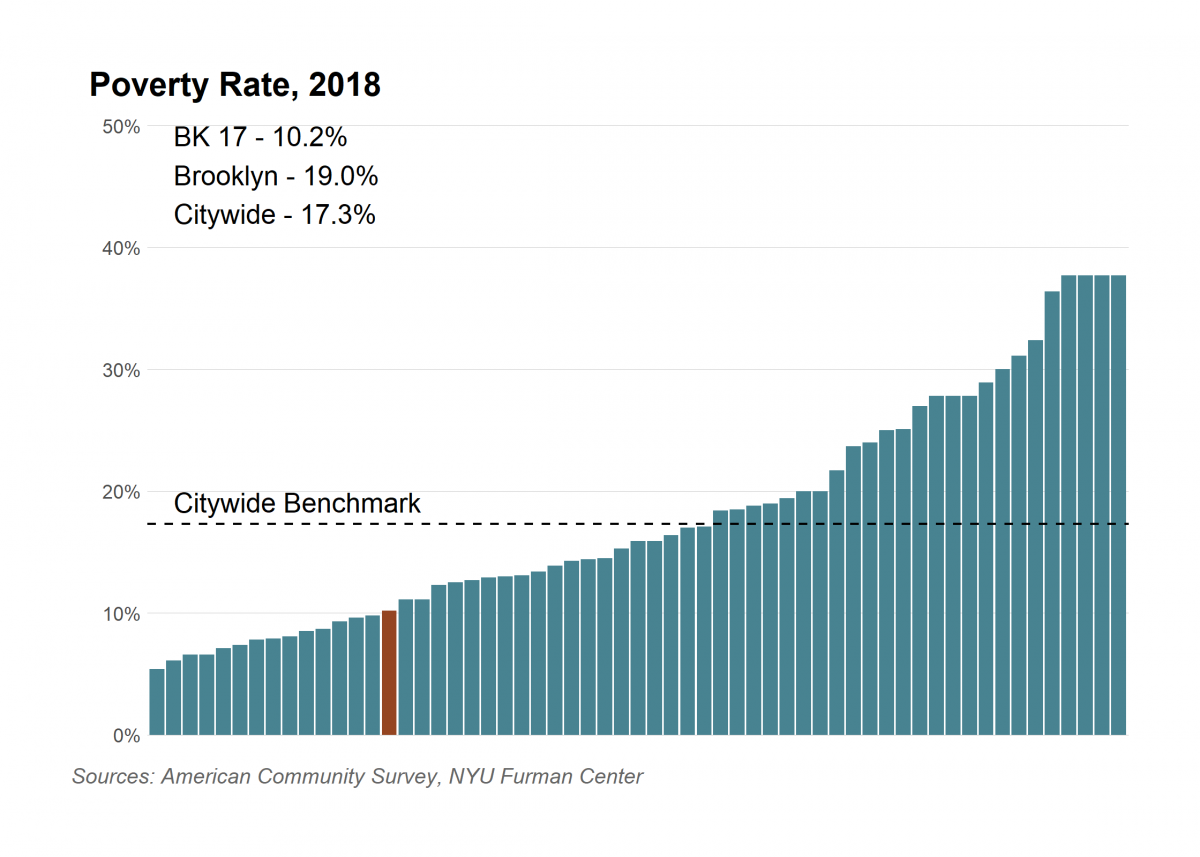
Residents of East Flatbush have low household incomes compared to their counterparts in larger metropolitan areas. The median household income in the community was estimated to be $59,050 compared to New York City’s median household income of $64,850 (NYU Furman Center, 2019). The community’s median household income is less than that of affluent urban areas such as Connecticut and New Jersey, with a higher median household income of $93,382 and $92,972 (Bishaw & Posey, 2016).
Consistently, the community reported a higher poverty rate of 10.2% compared to New York City’s 17.3% (NYU Furman Center, 2019). Similarly, as illustrated in Figure 1 below, the community has a low poverty rate compared to Brooklyn and NYC. Nevertheless, as illustrated in Figure 1 below, East Flatbush performed better than other rural areas, which reported the lowest median income, such as Mississippi, with an average of $40200 (Bishaw & Posey, 2016). Overall, the low income and high poverty rates contribute to poor maternal health and childbearing outcomes.
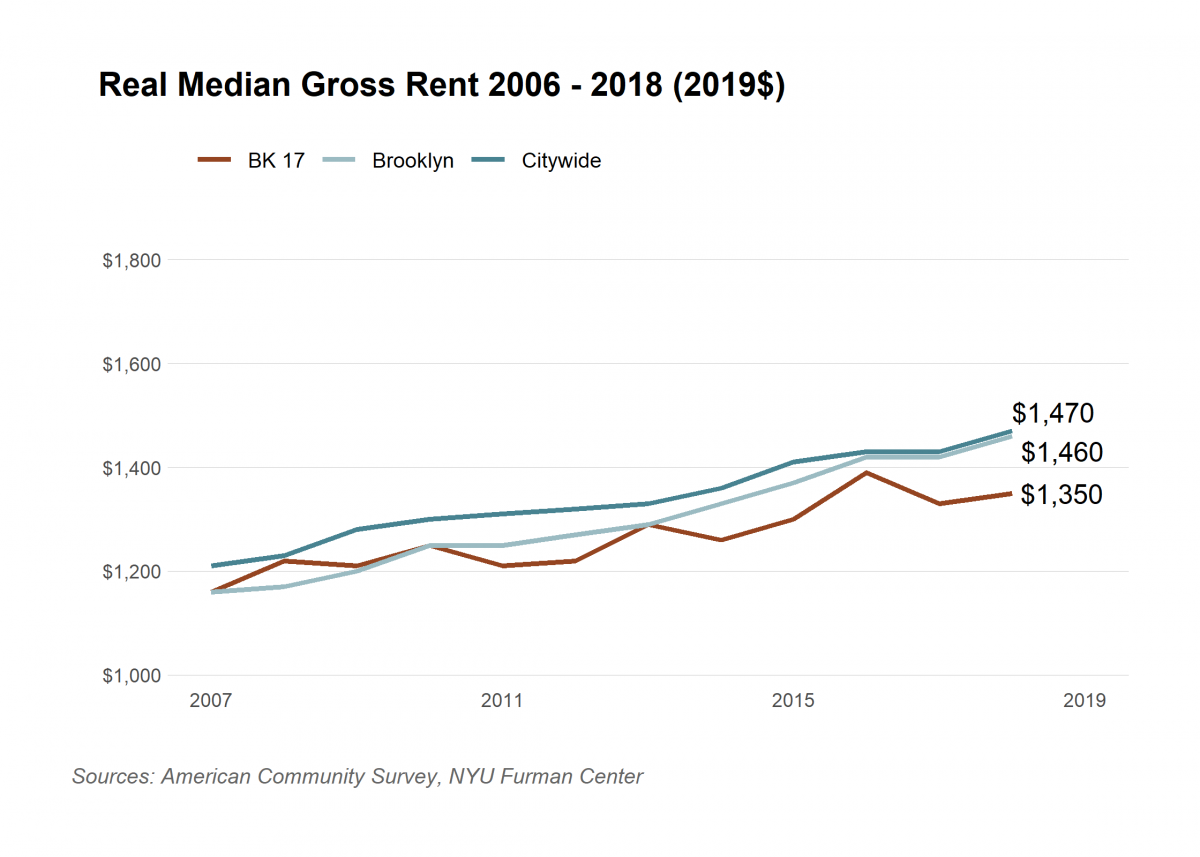
East Flatbush fares poorly in terms of housing compared to Brooklyn and NYC. As depicted in Figure 2, the community has experienced a steady increase in real median gross rent, rising from $1,160 to $1,350 between 2006 and 2018 (NYU Furman Center, 2019).
In 2018, the percentage of East Flatbush residents who owned homes was estimated at 36.3%, while 0.4% of rental units fell within the public housing category (NYU Furman Center, 2019). 0.4% of rental units in East Flatbush fell within the public housing category in 2018, with an overall vacancy rate of 3.4% (NYU Furman Center, 2019). These patterns indicate a higher housing burden in the future, which may exacerbate health disparities.
Major Health Problems in the Community
Tobacco, Alcohol, and Substance Abuse
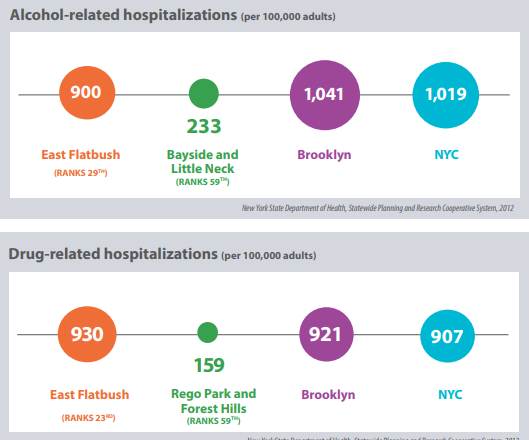
Alcohol and substance abuse is a serious public health problem in East Flatbush. In 2015, about 10% of the population were smokers, and a staggering 900 and 930 residents were hospitalized for alcohol and drug abuse, respectively (Figure 3). Besides that, there has been an increase in the number of women who use tobacco, alcohol, and other substances during pregnancies. This is a great risk to both the mothers and the unborn child (Wagner et al., 2019).
Heavy consumption of alcohol and drugs during pregnancies can negatively affect the mother and the unborn child. It can result in severe consequences such as miscarriage and low birth weight (Nyamasege et al., 2019). The reality is, all these drugs are dangerous to the expectant mother, unborn child, and even the infant in one way or the other.
Inadequate Nutrition
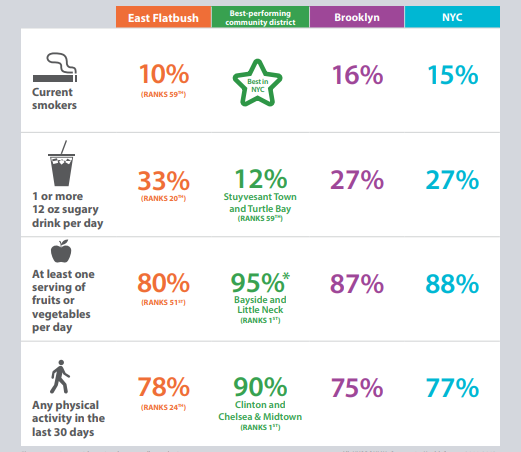
Poor nutrition is another serious public health issue in the selected community. As illustrated in Figure 4, 80% of East Flatbush residents manage to have at least one serving of fruits or vegetables per day (NYC Government, 2015). The community performs poorly compared to Brooklyn and New York City’s average of 87% and 88%, respectively (NYC Government, 2015).
Inadequate nutrition is a serious concern considering that it contributes to poor maternal health outcomes and complications such as preterm birth and low birth weight (Nyamasege et al., 2019). Inadequate nutrition can lead to poor maternal and infant health outcomes, including miscarriages and underweight children. A healthy pregnancy will translate to fit and easy childrearing.
Sexually Transmitted Infections (STIs)
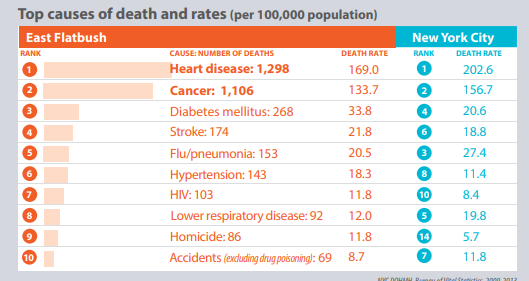
STIs affect men and women in most societies, including expectant mothers. East Flatbush is one of the boroughs with the highest new HIV diagnoses in NYC, emerging twelfth in the 2015 ranking (NYC Government, 2015). Besides that, HIV is among the leading causes of mortality rates in East Flatbush and NYC, with death rates of 11.8% and 8.4%, respectively (Figure 5). STIs such as HIV contribute to poor health outcomes during pregnancy and childbearing, including miscarriage, premature labor, disability, and even death. There is a strong need to conducting awareness campaigns to sensitize the population about the risk factors and best practices in managing STIs.
Factors Contributing to Illness during Childbearing
Maternal health problems and complications are a serious public concern in the US and globally. Nevertheless, there is a strong need to examine potential risk factors and root causes of the disorders and find effective ways of improving maternal health outcomes. This section explores some of the factors that contribute to health problems and complications during childbearing.
Pregnancy in Underage Women
A human being’s body develops with age. When an underage woman conceives, there is a high likelihood that they will develop severe medical conditions. Her reproductive system is still changing, and parts like the pelvis are still developing. Underage women are also likely to have a child with low birth weight due to their underdeveloped bodies (Guzzo et al., 2019).
Cases of poor nutrition are common in underage pregnant women as they are likely to develop poor eating habits. Pregnancies in underage women can be controlled through education to young girls and boys. Some of these pregnancies are from young schoolboys who need education on the risks of early pregnancies. Legal actions should be taken against any adult who engages in sexual activities with underage girls.
Women over the Age of 35
As women age, their chances of conception get lower, and even if they get pregnant, higher chances are, they might develop complications during delivery. These complications are brought about by some factors associated with aging, such as the underlying conditions of the mother, chromosomal issues- where older women are more likely to develop chromosomal-related complications compared to younger women, and miscarriages. The best strategy to overcome this challenge is educating aging women on the importance of bearing children in their twenties. At this point, their bodies are strong to overcome childbearing challenges naturally.
Obesity and Diabetes
Obesity and diabetes are highly prevalent in East Flatbush and NYC at large. In 2015, the percentage of adults who were obese and diabetic stood at 30% and 12%, respectively (NYC Government, 2015). Women who have accumulated more than the average required weight in their bodies are likely to develop complications when giving birth. Some difficulties that are likely to create are heart problems, spinal Bifida, and hydrocephaly.
Gestational diabetes might also be a possibility for obese women during pregnancy and at risk of high blood pressure. These factors may result in the birth of an underweight child. Obesity can be controlled by proper nutrition and engaging in physical body exercises. Adequate nutrition will dictate even the portion sizes that you are required to consume. Educating pregnant mothers on the importance of proper nutrition will go a long way in reducing cases of obesity in expectant mothers.
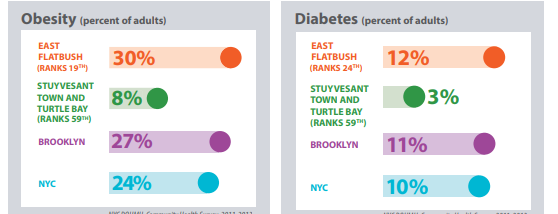
Health and Human Services Agencies Available in the Rural Community
Since the health status of rural communities is generally worse compared to other communities, there are several health and human services agencies that are available in these communities to help them overcome the health and environmental challenges. The central aim of these agencies is to improve and protect the health of rural populations (Bhatt & Bathija, 2018). A good example of the most relevant resources in the selected community includes the following.
The Federal Office of Rural Health Policy (FORHP)
FORHP is a federal agency whose primary purpose is promoting higher quality health care services delivery across all rural areas in the country. In the effort to exercise its legal mandate, FORHP has implemented several grassroots programs and initiatives that aim to ameliorate healthcare service delivery and ensure that all people who live in rural parts of America have access to better healthcare services.
To facilitate these services, the federal offices of rural health policy ensure they liaise with the funding programs to get the required money. The office also engages in other programs such as rural hospital programs, rural community programs, and telehealth programs to ensure they acquire enough funds to facilitate health improvement and accessibility to quality health care among the rural communities.
The Centers for Disease Control and Prevention (CDC)
CDC is an agency whose focus is to communicate the important matters that can help on improving rural health. Though the agency does not have a centralized office like the federal office, it works through the office of the associate director of policy and strategy to ensure programmatic and rural-relevant policies are well coordinated. The agency has various websites and centers such as the CDC Center for surveillance, the laboratory services, and the CDC Center for epidemiology, which they use for communication in providing briefs on health policies, information, and policy options available for proper handling of rural and public health issues among the rural communities.
The US Department of Agriculture
The Department of agriculture works hand in hand with public health agencies to support health in rural communities through the provision of financial services to the residents and businesses. Focusing on their mission for rural development, the department provides funds for water development, health care facilities, waste disposal programs, and many other programs to address rural health problems, build infrastructure, and manage the determinants of rural communities’ health issues.
The department also provides funds to facilitate activities that ensure there is food security in the rural communities and other programs that aim at promoting the well-being of the rural communities. A good example of such an initiative is the supplemental nutrition assistance program (SNAP).
Steps for Referring a Patient/Family to Identified Agencies
An effective referral process ensures patients will receive quality services from agencies and also facilitates cohesion at all levels of a health care system. In addition, an effective referral process will make the utilization of primary health care services and hospitals cost-effective (Richman et al., 2019). Health practitioners should adopt the following steps for referring patients to health and human service agencies.
Develop Written Policies for Referrals
Rural community health centers should have a written policy that contains agency information that guides their nurses and health practitioners on how to handle and implement referrals. Following these policies will help patients access agencies closer to their residential areas and also help them save the cost of traveling far to get medical attention.
Follow Established Referral Systems
Clinicians and nurses should follow their established referral systems to guide them in determining when a patient requires medical services or attention that is beyond the clinic services. In this case, nurses should use their best judgment in determining the client’s circumstances and identify the best type of agency that best suits their conditions.
Build Strong Relationships with Relevant Agencies and Other Service Providers
Before they can refer patients, nurses need to determine whether the agency can meet the demands of the target population and establish whether there will be mutual benefits in establishing formal or informal relationships with them. In this step, the health practitioners need to develop local resources such as getting the agency contact information, verify the information like contact hours, opening and closing time as well as the location to make sure all the information is updated. Besides, there is a need to initiate a conversation with the agency to discuss key issues and determine the added value for potential referrals.
Establish Referral Agreements with the Agencies
Once all the information is obtained and verified, the next step is to sign a memorandum of understanding. The public health facility will get a written agreement that binds them with the agency. In reaching this memorandum of experience, the health facility issues require a meeting with the agency leaders and develop a mutual referral memorandum of association. Signing and mailing a draft of the MOU and cover letter will help the two parties have a binding agreement.
Provide Proactive Referrals
The staff of the public health facility must be in a position to provide referrals to the agencies proactively. To achieve this, they require to develop processes and implement them accordingly. In addition, they need to provide all their staff and clinic administration with an understanding of the importance of adequate referral provision and also provide them with a chance to exercise their skills in identification of referral needs, talking to the agencies, and following up with the clients concerning referrals.
Develop and Document System Support
The last step of an effective referral system is the development and documentation of the system support. All the information concerning the agency, the memorandum of associations, and the clients referred to the agencies need to be documented. Documentation of all issues concerning referrals facilitates an easy process and smooth transition of events from the health care center to the agency and vice versa.
Importance of A Healthy Community in Successful Childbearing/Childrearing
The community plays an integral role in maternal care and successful childbearing. Most importantly, a healthy community translates to overall well-being and the successful bringing of the children. Besides that, a healthy community promotes effective maternal care through increasing access to basic resources and services, including food, housing, transportation, and healthcare.
When mothers receive good maternal care, eat well, and receive good checkups, there will reduced chances of anemia which might cause complications during childbearing. Good and balanced nutrition during pregnancy also leads to the excellent brain development of the infant and hence increases the chances of giving birth to a healthy baby. Besides, there will be low chance of getting complications during childbearing (Guzzo et al., 2019). In addition, the babies will be healthy, have a good birth weight, and have low chances of developing congenital disabilities.
Besides that, a healthy community improves maternal, newborn, and child health through empowering women, especially those who are expectant and with young children. They encourage women to participate and embrace locally-based interventions, consequently enhancing utilization and access to healthcare services and other resources that can help support childbearing. Therefore, there is a strong need to involve local communities in planning, implementing, and monitoring community-based maternal care services to improve maternal and childbearing outcomes.
Overall, people who live in rural areas in the US face a huge disease burden and health disparities. This problem is attributable to several factors, including high poverty rates, lack of awareness, and limited access to quality healthcare services. This has facilitated people developing conditions that would otherwise be avoidable. Therefore, this calls for the respective governments to develop health plans that will promote the overall well-being of all communities in the rural areas.
References
Bhatt, J., & Bathija, P. (2018). Ensuring access to quality health care in vulnerable communities.Academic Medicine, 93(9), 1271. Web.
Bishaw, A. & Posey, K., G. (2016). A comparison of rural and urban America: Household income and poverty. United States Census Bureau. Web.
Guzzo, K. B., Hayford, S. R., & Lang, V. W. (2019). Adolescent fertility attitudes and childbearing in early adulthood. Population Research and Policy Review, 38(1), 125-152. Web.
Nyamasege, C. K., Kimani-Murage, E. W., Wanjohi, M., Kaindi, D. W., Ma, E., Fukushige, M., & Wagatsuma, Y. (2019). Determinants of low birth weight in the context of maternal nutrition education in urban informal settlements, Kenya. Journal of Developmental Origins of Health and Disease, 10(2), 237. Web.
NYC (New York City) Government. (2015). Community Health Profiles 2015: Brooklyn Community District 17: East Flatbush. Web.
NYU Furman Center. (2019). Neighborhood Indicators: BK17 East Flatbush. NYU Furman Center. Web.
Richman, L., Pearson, J., Beasley, C., & Stanifer, J. (2019). Addressing health inequalities in diverse, rural communities: An unmet need.SSM-Population Health, 7, 100398. Web.
U.S. Census Bureau (2019). American Community Survey 5-year estimates. Census Reporter. Web.
US Census Bureau. (2016). New census data show differences between urban and rural populations. United States Census Bureau. Web.
Wagner, J., Neitzke-Spruill, L., O’Connell, D., Highberger, J., Martin, S. S., Walker, R., & Anderson, T. L. (2019). Understanding geographic and neighborhood variations in overdose death rates. Journal of Community Health, 44(2), 272-283. Web.